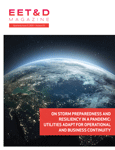
Over the past months, all of us – whether we live in rural or urban areas, in North America. or on the other side of the planet – have been affected by the COVID crisis. Depending on our ages, health conditions, jobs or countless other circumstances, we and the people we love may have experienced the pandemic. Regardless, we all share in reacting to the impacts of COVID-19 and the fact that we are part of a seminal experience that future generations will read about in history books.
The electric energy sector has been affected by the pandemic in ways that may take years to recognize or understand. To get a pulse on where the industry is at this time, several articles in this Q3 issue of EET&D address how utilities can rebound from the pandemic and prepare for whatever new crises may come our way.
In early May, the IEEE Power & Energy Society (PES) published a white paper titled, Sharing Knowledge on Electrical Energy Industry’s First Response to COVID-19. Leveraging IEEE PES’s 39,000+ members representing every continent except for Antarctica, the white paper documents how the pandemic has affected utilities, their employees and energy consumers around the world. Dr. Faroosh Rahmatian, past chair, IEEE Power & Energy Technical Council, discusses the findings of this white paper in an article he wrote for the “Grid Transformation Forum” section of this issue.
According to Rahmatian, one of the white paper’s findings is that utilities recognize the pandemic will have mid- and long-term effects on storm preparedness and resiliency. One positive outcome of the pandemic response is that over the past several years, those utilities that have invested time and money on grid modernization and storm preparedness have a better chance of coming through the pandemic, less adversely affected than those utilities that are lagging in resilience planning.
Next, Rahmatian discusses what must happen going forward to ensure that those organizations and workers that make up the electric energy industry remain safe and healthy as the world recovers from the economic and physical toll of the pandemic. In addition to providing a broader overview of how the pandemic has impacted utilities, and what that means, Rahmatian’s article includes a link to the IEEE PES white paper, so readers can find more specific information on how utilities of varying sizes and in different geographic locations have fared so far during this crisis.
John Villali, a research director for IDC Energy Insights, suggests in his article, “Accelerating Digital Transformation Amid Covid-19”, priorities on which the industry should focus to establish a “new normal” working environment. Specifically. Villali points to the importance of investing in technology, like robotic process automation and cloud computing, “that can improve efficiencies, safety measures as well as save costs in these current economic times and in the long run.”
For the near-term, utilities have focused on investing in technology that makes it seamless for essential staff to work remotely, while also addressing requirements for line workers and plant operators, who must work on site.For the long-term, the COVID-19 pandemic has shone a light on “advanced technologies and processes that can improve the operations and management of power generating assets.”
As utilities resume operations post-pandemic, resiliency and asset management are expected to be priorities for utilities while they consider both short- and long-term-technology investments.
In “Preparing for the 2020 Storm Season Amidst COVID-19”, TK Subramanian, with Tata Consultancy Services, reminds us that the COVID pandemic is not the first time we have faced such a far-reaching crisis and that, as utilities take a multi-phased-approach to fully-reopening, now is the time to create or update policies and processes for storm preparedness and disaster recovery.
It is unknown how long this pandemic will endure or when there will be a proven vaccine for the virus; nor will we understand any time soon what the full impact of the pandemic will be on the utility sector. And now that summer has arrived in the Western Hemisphere, utilities have the added pressures of extreme fire and storm seasons to contend with on top of a pandemic. This means there is the potential that several crises could collide at once.
It may seem out of our reach to grasp what it is entailed with preparing, reacting and reemerging unscathed, once we are “on the other side of the pandemic,” but there is a plus side to all of this. With the information our subject matter experts share in this issue, it should be clear to our readers that there is no shortage of industry expertise to provide advice or valuable resources. For those who remain unsure of how to find the people or tools needed to survive these challenges, consider the thought leaders who have contributed to this issue. They are a great reminder that no one has to go through this alone, and they have the experience that can help the rest of us find our way.
If you would like to contribute an article or if you have an idea about interesting technology, solutions, or suggestions, please email me at: Elisabeth@ElectricEnergyOnline.com
Elisabeth






